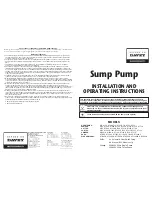
Operating Instructions, Form No. 102838, Back sheet 2 of 3
TROUBLE-SHOOTING GUIDE
●
To help prevent personal injury, any repair work or trouble-shooting must be done by qualified personnel
familiar with this equipment.
●
Use the proper gauges and equipment when trouble-shooting.
NOTE:
●
It is best to check for leaks by using a hand pump and applying pressure to the suspect area without the
motor running. Watch for leaking oil and follow it back to its source.
●
Plug the outlet ports of the pump when checking for leakage to determine if the leakage is in the pump or
in the cylinder or tool.
PROBLEM CAUSE SOLUTION
Pump is not delivering oil or
delivers only enough oil to
advance cylinder(s) partially or
erratically.
1. Oil level too low.
2. Loose-fitting coupler to cylinder.
3. Air in system.
4. Air leak in suction line.
5. Dirt in pump or filter plugged.
6. Oil is bypassing through a
double-acting cylinder.
7. Cold oil or oil is too heavy
(Hydraulic oil is of a higher
viscosity than necessary).
8. Relief valve or low pressure
unloading valve out of
adjustment.
9. Reservoir capacity is too small
for the size of the cylinder(s)
used.
10. Defective directional valve.
11. Sheared drive shaft key(s).
12. Vacuum in reservoir.
1. With all cylinders retracted, fill
reservoir to 1" of fill hole.
2. Check quick-disconnect
couplings to cylinders. Inspect
couplers to ensure that they are
completely coupled.
Occasionally couplers have to be
replaced because the ballcheck
does not stay open due to wear.
3. Bleed the system.
4. Check and tighten suction line.
5. Pump filter should be cleaned
and, if necessary, pump should
be dismantled and all parts
inspected and cleaned.
6. By removing the cylinder and
capping the hoses, the pump
and valve can be checked.
Observe if pump holds pressure.
7. Change to lighter oil.
8. Adjust as needed.
9. Use smaller cylinder(s) or larger
reservoir.
10. Inspect all parts carefully and
replace if necessary.
11. Replace.
12. Check for plugged vent in
breather cap.
WARNING
























